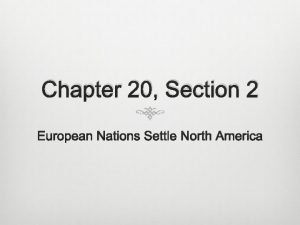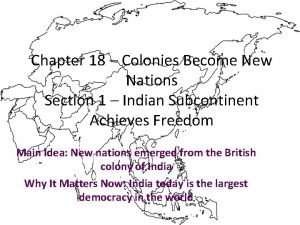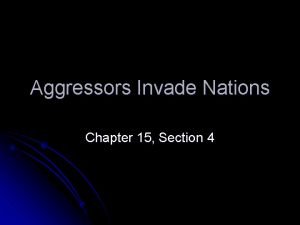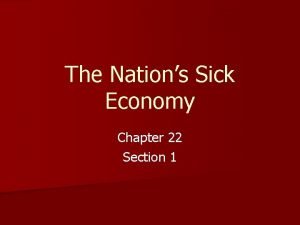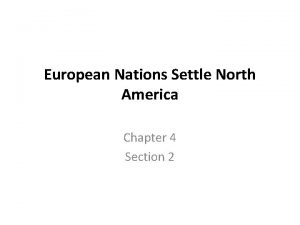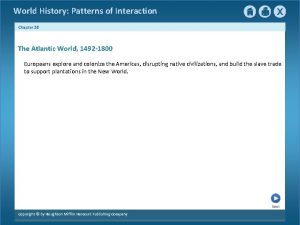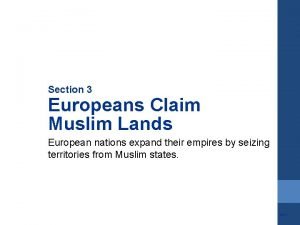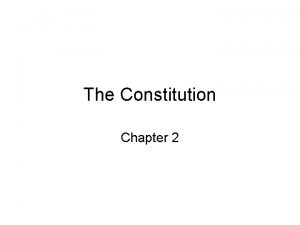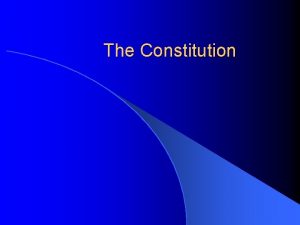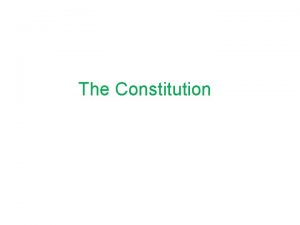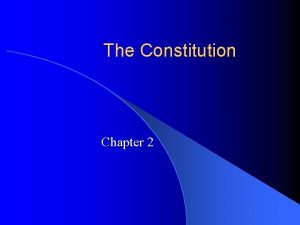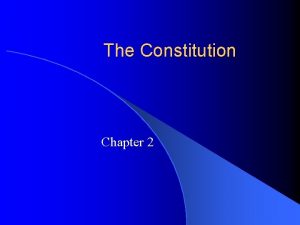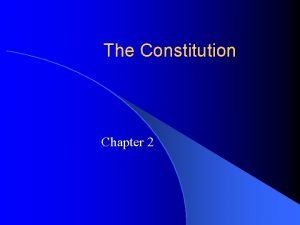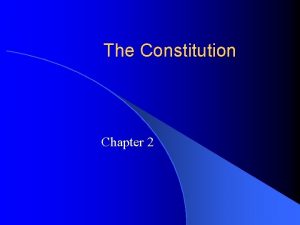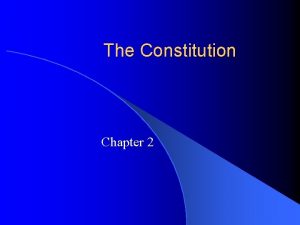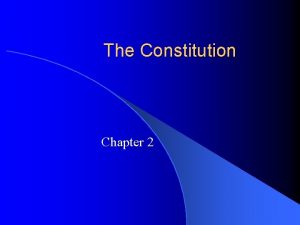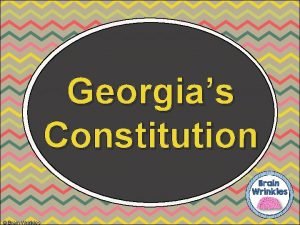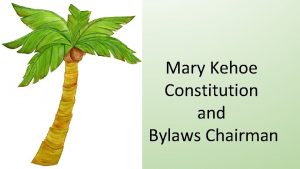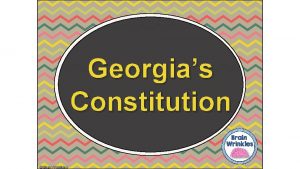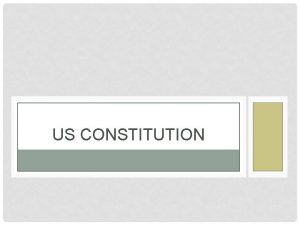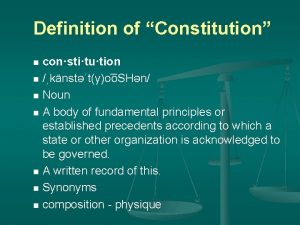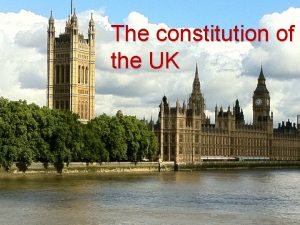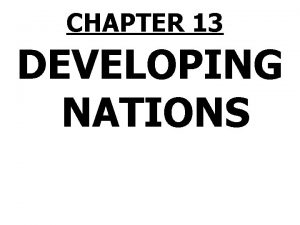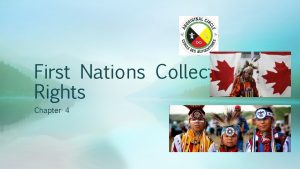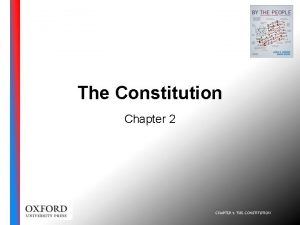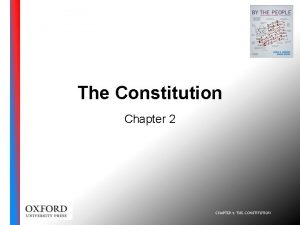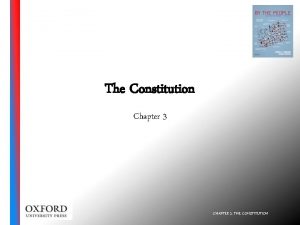Chapter 2 THE CONSTITUTION Constitution Definition A nations























- Slides: 23

Chapter 2 THE CONSTITUTION

Constitution � Definition �A nation’s basic law. It creates political institutions, assigns or divides powers in government, and often provides certain guarantees to citizens. � Sets the broad rules of the game. � The rules are not neutral- some participants and policy options have advantages others don’t.

The Origins of the Constitution � The Road to Revolution �Colonists didn’t like the way they were treated. � Declaring Independence �The Declaration of Independence listed the colonists grievances against the British.

The Origins of the Constitution � The English Heritage: The Power of Ideas �John Locke’s influence �Natural rights �Consent of the governed �Limited Government � The “Conservative” Revolution �Restored rights the colonists felt they had lost �Not a major change of lifestyles

The Government That Failed � The Articles of Confederation �The first document to govern the United States �Congress had few powers �States could engage in foreign trade � Changes in the States �Expanded political power for some �Expanding economic middle class �Ideas of equality spreading

The Government That Failed � Economic Turmoil �States had different currencies �States had laws that favored debtors � Shays’ Rebellion �A series of attacks on courthouses by a small band of farmers led by Revolutionary War Captain Daniel Shays to block foreclosure proceedings.

The Government That Failed � The Aborted Annapolis Meeting �An attempt to discuss changes to the Articles of Confederation. �Attended by only 12 delegates from 5 states. �Called for a meeting in May 1787 to further discuss changes.

Making a Constitution: The Philadelphia Convention � Gentlemen in Philadelphia � 55 men from 12 of the 13 states �Mostly wealthy planters & merchants �Most were college graduates with some political experience �Many were coastal residents from the larger cities, not the rural areas

The Philadelphia Convention, continued � Philosophy into Action �Human Nature �Political Conflict �Objects of Government �Nature of Government

The Agenda in Philadelphia � The Equality Issues �Equality and Representation of the States ○ New Jersey Plan ○ Virginia Plan ○ Connecticut Compromise �Slavery �Political Equality

The Agenda in Philadelphia

The Agenda in Philadelphia � The Economic Issues �States had tariffs on products from other states �Paper money was basically worthless �Congress couldn’t raise money �Actions taken: �Powers of Congress to be strengthened �Powers of states to be limited

The Agenda in Philadelphia

The Agenda in Philadelphia � The Individual Rights Issues �Some were written into the Constitution: ○ Writ of habeas corpus ○ No bills of attainder ○ No ex post facto laws ○ Religious qualifications for holding office prohibited ○ Strict rules of evidence for conviction of treason ○ Right to trial by jury in criminal cases �Some were not specified ○ Freedom of speech / expression ○ Rights of the accused

The Madisonian Model � Limiting Majority Control � Separating Powers � Creating Checks and Balances � Establishing a Federal System

The Madisonian Model The Constitution and the Electoral Process: The Original Plan (Figure 2. 2)

The Madisonian Model Figure 2. 3

The Madisonian Model � The Constitutional Republic �Republic: A form of government in which the people select representatives to govern them and make laws. �Favors the status quo - changes are slow � The End of the Beginning �The document was approved, but not unanimously. Now it had to be ratified.

Ratifying the Constitution � Federalist Papers �A collection of 85 articles written by Alexander Hamilton, John Jay, and James Madison under the name “Publius” to defend the Constitution. � Bill of Rights �The first 10 amendments to the U. S. Constitution, drafted in response to some of the Anti-Federalist concerns about the lack of basic liberties.

Ratifying the Constitution

Constitutional Change Figure 2. 4

Constitutional Change � The Informal Process of Constitutional Change �Judicial Interpretation �Changing Political Practice �Technology �Increasing Demands on Policymakers

Understanding the Constitution � The Constitution and Democracy �The Constitution itself is rarely described as democratic. �There has been a gradual democratization of the Constitution. � The Constitution and the Scope of Government �Much of the Constitution limits government. �The Constitution reinforces individualism, yet encourages hyperpluralism.
 Texas constitution vs u.s. constitution venn diagram
Texas constitution vs u.s. constitution venn diagram Nc constitution vs us constitution
Nc constitution vs us constitution Constitution what is constitution
Constitution what is constitution The constitution lesson 1 principles of the constitution
The constitution lesson 1 principles of the constitution The colonies become new nations
The colonies become new nations Chapter 20 section 2 european nations settle north america
Chapter 20 section 2 european nations settle north america The colonies become new nations
The colonies become new nations Chapter 15 section 4 aggressors invade nations
Chapter 15 section 4 aggressors invade nations Aggressors invade nations
Aggressors invade nations Chapter 15 section 4 aggressors invade nations
Chapter 15 section 4 aggressors invade nations Chapter 22 section 1 the nation's sick economy
Chapter 22 section 1 the nation's sick economy Chapter 20 section 2 european nations settle north america
Chapter 20 section 2 european nations settle north america Chapter 20 section 1 world history
Chapter 20 section 1 world history Europeans claim muslim lands
Europeans claim muslim lands Chapter 20 section 2 european nations settle north america
Chapter 20 section 2 european nations settle north america Hát kết hợp bộ gõ cơ thể
Hát kết hợp bộ gõ cơ thể Slidetodoc
Slidetodoc Bổ thể
Bổ thể Tỉ lệ cơ thể trẻ em
Tỉ lệ cơ thể trẻ em Chó sói
Chó sói Tư thế worm breton là gì
Tư thế worm breton là gì Chúa sống lại
Chúa sống lại Môn thể thao bắt đầu bằng chữ f
Môn thể thao bắt đầu bằng chữ f Thế nào là hệ số cao nhất
Thế nào là hệ số cao nhất





